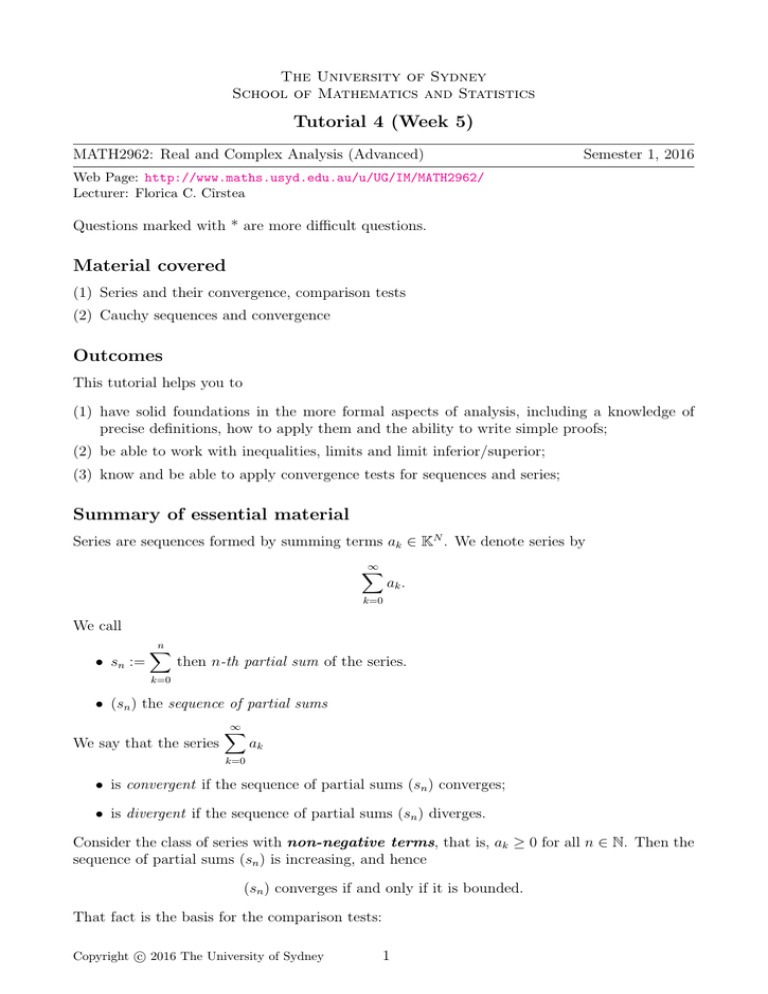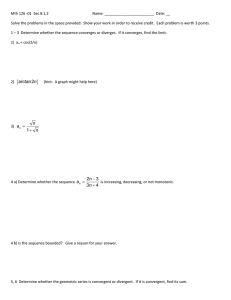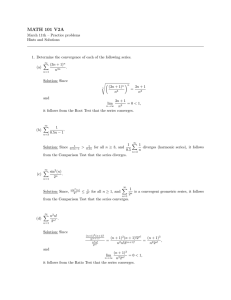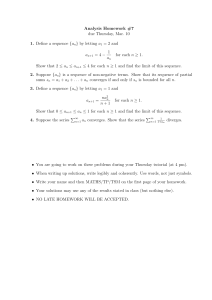Tutorial 4 (Week 5) Material covered Outcomes Summary of
advertisement

The University of Sydney School of Mathematics and Statistics Tutorial 4 (Week 5) MATH2962: Real and Complex Analysis (Advanced) Semester 1, 2016 Web Page: http://www.maths.usyd.edu.au/u/UG/IM/MATH2962/ Lecturer: Florica C. Cı̂rstea Questions marked with * are more difficult questions. Material covered (1) Series and their convergence, comparison tests (2) Cauchy sequences and convergence Outcomes This tutorial helps you to (1) have solid foundations in the more formal aspects of analysis, including a knowledge of precise definitions, how to apply them and the ability to write simple proofs; (2) be able to work with inequalities, limits and limit inferior/superior; (3) know and be able to apply convergence tests for sequences and series; Summary of essential material Series are sequences formed by summing terms ak ∈ KN . We denote series by ∞ X ak . k=0 We call • sn := n X then n-th partial sum of the series. k=0 • (sn ) the sequence of partial sums We say that the series ∞ X ak k=0 • is convergent if the sequence of partial sums (sn ) converges; • is divergent if the sequence of partial sums (sn ) diverges. Consider the class of series with non-negative terms, that is, ak ≥ 0 for all n ∈ N. Then the sequence of partial sums (sn ) is increasing, and hence (sn ) converges if and only if it is bounded. That fact is the basis for the comparison tests: c 2016 The University of Sydney Copyright 1 Comparison test. Suppose that there exists m ∈ N so that 0 ≤ ak ≤ bk for all k ≥ m. • If • If ∞ X k=0 ∞ X bk converges, then ak diverges, then k=0 ∞ X ak converges. k=0 ∞ X bk diverges. k=0 Limit comparison test. Suppose that there exists m ∈ N so that 0 ≤ ak and 0 < bk for all k ≥ m, and that a an n <∞ or equivalently is bounded lim sup bn n∈N n→∞ bn • If • If ∞ X k=0 ∞ X bk converges, then ak diverges, then k=0 ∞ X ak converges. k=0 ∞ X bk diverges. k=0 Questions to complete during the tutorial 1. (a) Suppose that f : [1, ∞) → R is a positive decreasing function and set an := f (n) for n ∈ N. For n ≥ 1 define Z n n X ak and In := f (x) dx. sn := 1 k=1 (i) Use upper and lower Riemann sums for the integral In to show that, for all n ≥ 2, sn − a1 ≤ In ≤ sn − an . (ii) Hence establish the Integral Test: Suppose that an = f (n) where f (x) is ∞ X positive decreasing on [1, ∞). Then an is convergent if and only if n=1 Z ∞ Z n→∞ 1 (b) Use the integral test to show that n f (x) dx < ∞. f (x) dx := lim 1 ∞ X 1 is convergent if and only if p > 1. p n n=1 2. Determine which of the series below converge, and which diverge. (a) (b) (c) ∞ X n=1 ∞ X n=1 ∞ X n=1 1 ; 2 2n + n + 1 (d) 1 ; 2 2n − n + 1 (e) 1 ; 2n − 1 (f) ∞ X n=1 ∞ X n=0 ∞ X n=1 1 √ ; 1+3 n (g) 2n − 1 ; 3n + 1 (h) n 2 +1 ; 3n − 1 2 *(i) ∞ X n=2 ∞ X n=1 ∞ X n=1 n2 1 ; log n log n ; n n ; 4n 3. Consider two sequences (an ) and (bn ) in R or C with bn 6= 0 for all n ∈ N. We call the sequence (an ) equivalent to (bn ) if lim n→∞ an = 1. bn If that is the case, we write an ∼ bn . (a) Show that equivalence of sequences is an equivalence relation, that is, it has the following properties: (i) an ∼ an (reflexivity); (ii) an ∼ bn ⇒ bn ∼ an (symmetry); (iii) an ∼ bn and bn ∼ cn implies that an ∼ cn (transitivity). (b) Suppose that an ∼ bn . Show that (an ) converges if and only if (bn ) converges. In case of convergence show that the limits of (an ) and (bn ) are the same. Extra questions for further practice 4. Let ak , bk >P 0 for all k ∈ N and suppose that ak ∼ bk . Show that and only if ∞ k=0 bk converges. P∞ k=0 ak converges if 5. Prove that the following sequences are equivalent and decide whether they converge or diverge. √ 4 4n + 1 n2 + 3 n 3n/2 ∼ (a) (c) ∼ 3n − 1 3 n4 + 3n + 1 n4 n X 1 n n 3 +2 *(d) ln n ∼ sn := ∼1 (b) n k k=1 3 − 2n 6. Let (xn ) be a sequence in RN and (an ) a sequence in R withPan ≥ 0 for all n ∈ N. Assume that kxn+1 − xn k ≤ an for all n ∈ N, and that the series ∞ k=0 ak converges. Show that (xn ) is convergent. Hint: Rewrite the sequence as a telescoping sum and apply the Cauchy criterion. Challenge questions (optional) *7. Suppose that f : KN → KN is a function such that there exists L ∈ (0, 1) with kf (x) − f (y)k ≤ Lkx − yk for all x, y ∈ KN . A function with that property is called a contraction since any pair of image points is closer together than the original points. (a) Let x0 ∈ KN and define xn+1 := f (xn ) for n ≥ 0. Show that (xn ) is a Cauchy sequence. (b) Show that there is a unique point in KN such that x = f (x). 3





